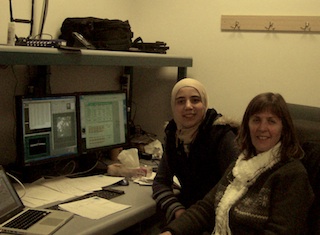
 |
Margaret M. Hanson, Ph.D.
Professor of Physics, Associate University Dean 


Later, it became obvious that very massive stars, even fully formed and no longer so young, might also experience great line of sight extinction purely due to their distance in the Milky Way galaxy. in 2003 I postulated that our Milky Way galaxy could quite possibly contain tens of extremely massive star clusters (masses > 104 solar mass), yet we had no clear means for detecting them (Hanson (2003). With collaborators Jura Borissova, Rudy Kurtev (Universidad Valparaiso, Chile) and Valentin Ivanov (ESO-Santiago), and greatly aided through the VVV Survey collaboration (P.I.s Dante Minniti and Phil Lucas) we began applying near-infrared observational methods to detect and characterize massive stellar clusters deep within our galaxy.
The image to the right shows me with my PhD graduate student, Randa
Asa'd, as we finish a night observing with the SOAR Telescope on
Cerro Pachon, Chile, in June 2010.

For a professional audience:
Click here for a quicktime .MOV file (NOTE: 146 MB)
This talk was given Nov 23rd,
2010 at
The Australian Astronomical Observatories (AAO), Sydney.
For a more general science audience: click here for streaming .WMV file
This talk was
given Oct 12th, 2010, for the Sigma Xi Annual Banquet